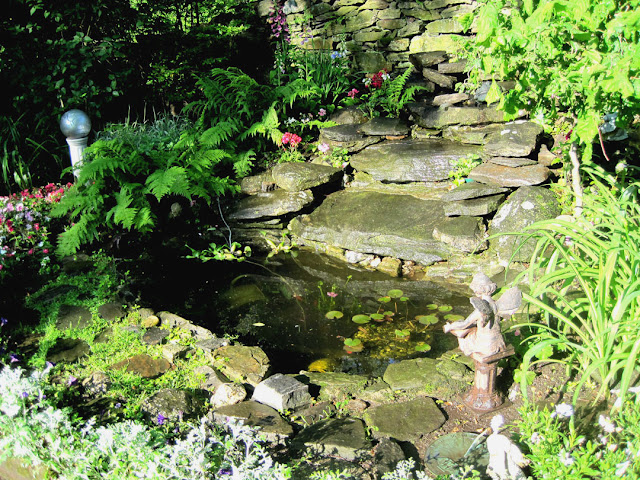On Sunday June 5, 2011 I posted this brief history of our house and the development of our "secret garden". So I thought it was the perfect time to post it again. Sadly, one of the two giant weeping willows is no longer with us. As you read here earlier this month, when it was cut down, the willow held its own secret--a nest of raccoons, but they all got out alive.
Ever since the tornados several days ago and the arrival of house
guests, I've been neglecting this blog. (Our electricity was out this
morning, but now it's back. Luckily the worst of the destruction
stopped 20 miles away.)
Next Sunday (June 12) in our town of Grafton, MA, the Historical Society and the Garden Club are sponsoring a tour of nine "Historic Homes and Gardens" and ours is one of them. So I thought I'd post the brief house history/garden write-up that I prepared for the booklet and show you some photos of the "Secret Garden" (plus grape arbor, pool, fish pond and waterfall) that we've put into the stone foundation of the Colonial Barn on our property that burned down in 1965 . When we bought the place in 1974, the area where the barn burned was filled with weeds and rubble, but it was my husband's idea to fill it with a pond, swimming pool and "secret garden."
The Daniel Rand House -- Grafton MA. The
rear wing of this building was the original house, built in 1723 by
Daniel Rand, one of the original proprietors of Shrewsbury. On Dec.
15, 1723, his son Solomon was the first child baptized in the town when
it was incorporated. Solomon lived 80 years and is buried on the
property. His gravestone is on display in the lower garden. Two of
Solomon’s sons served in the Revolutionary War. In
1822, the property was sold at public auction to Tarrant Merriam of
Grafton, a wealthy landholder who built the Greek Revival farmhouse
which now faces Nelson Street. Because he didn’t like to go all the way
to Shrewsbury Center to church, Merriam had the boundary of Grafton
moved slightly to the north, so that the house is now in Grafton.
Next Sunday (June 12) in our town of Grafton, MA, the Historical Society and the Garden Club are sponsoring a tour of nine "Historic Homes and Gardens" and ours is one of them. So I thought I'd post the brief house history/garden write-up that I prepared for the booklet and show you some photos of the "Secret Garden" (plus grape arbor, pool, fish pond and waterfall) that we've put into the stone foundation of the Colonial Barn on our property that burned down in 1965 . When we bought the place in 1974, the area where the barn burned was filled with weeds and rubble, but it was my husband's idea to fill it with a pond, swimming pool and "secret garden."
The
Rands built an enclosed walkway from their house to the barn so they
could feed the animals without plowing through snow. This very large
Colonial barn, measuring 120 feet by 45, burned down in 1965, taking
with it four horses and a cradle believed to have come over on the
Mayflower. All that remained was the stone foundation, which now serves
as the walls surrounding the enclosed garden and pool area.
From
Nelson Street the “Secret Garden” inside the barn foundation walls is
invisible, but plantings of perennials can be seen on the left side of
the house and running along the fence that leads to a second (modern)
structure built twenty years ago to serve as guest house, office and
(on the lower level) a garage, rec room and bathroom, opening onto the
pool.
In
the pool area there is a rock garden, small waterfall and fishpond on
the far (south) end, plantings of impatiens, foxglove, irises and
shade-loving perennials. Antique cast-iron garden furniture and small
garden sculptures can be seen throughout the area. On the near (north)
end of the enclosure is a grape arbor , supported by a pergola with
ionic columns. Hydrangeas, hibiscus, roses and many perennials bloom
throughout the season.
When
the house and three acres of property were bought from from Richard
and Marie-Louise Bishop in 1974, it came with the two large weeping
willows, three different colors of lilac bushes, an apple tree,
blackberry patches , lilies of the valley and a wide variety of irises.
















No comments:
Post a Comment